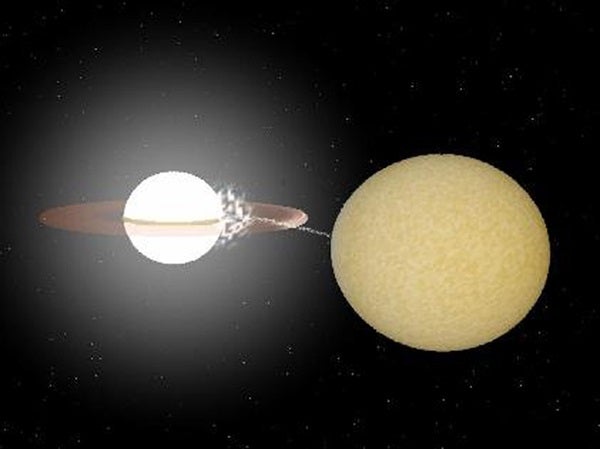Violent eruptions from an interacting pair of stars that orbit around each other every 25 minutes were spotted by a team of astronomers led by Gavin Ramsay of Armagh Observatory, in the United Kingdom. Usually, these outbursts take place at regular and predictable intervals, erupting every 2 months. The new observations were made using the fully robotic Liverpool Telescope situated in the Canary Islands and the orbiting Swift Observatory.
The stars are helium-rich white dwarfs, the compact remnants that are the end state of stars like our Sun. Reflecting their location in the direction of the constellation of Draco, the stars are named KL Dra. They are separated by a distance equivalent to just half that between the Earth and Moon, close enough for the more massive partner to drag helium off its lighter companion.
The resulting stream of helium travels from one white dwarf and eventually lands on the other at speeds of millions of miles per hour. Most of the time, the material gets jammed up in a swirling disk around the accreting companion with only a trickle landing on the star itself, causing it to quietly glow at optical, ultraviolet, and X-ray energies. However, the team discovered that every 2 months the material in the disk gets suddenly released in a giant eruption that causes the stellar system to shine tens of times more brightly than before.
This binary is one of few systems on a strict helium diet. The hydrogen that was originally in both stars has long been converted into helium and heavier elements. Almost all other interacting binary systems so far discovered transfer hydrogen material instead. Because helium is heavier and has different properties to hydrogen, the team expected the eruption properties of KL Dra to be different from those of the more familiar hydrogen-eating binaries.
As KL Dra is a helium-eating binary that erupts regularly and predictably, scientists can plan detailed and sensitive observations using a range of telescopes when it is in outburst. These observations will potentially have wide-ranging implications because the same general process of accretion takes place in many astrophysical systems, ranging from young stars in the process of forming to massive black holes found at the center of galaxies.
The team of astronomers obtained complementary observations of KL Dra using the Swift Observatory. This showed that the eruption was seen strongly in ultraviolet (UV) light. Surprisingly, unlike the hydrogen-eating binaries, there was no change in the system’s brightness in X-rays during the eruption.
“We have a program to take observations of a dozen helium-eating binaries using the Liverpool Telescope to see if they behave in the same way,” said Tom Barclay at Armagh Observatory and the University College London’s Mullard Space Science Laboratory.
It was a big surprise to see a second outburst from KL Dra just 2 months after the first. We then predicted the next outburst would start on December 7 of last year. It was very exciting when our observations showed that it went into outburst on exactly that date!”
“Thankfully, X-rays and most UV radiation doesn’t get through Earth’s atmosphere, so only space-based observatories can observe the high-energy emission from these extreme objects, said Simon Rosen of the University of Leicester and part of the team who made the discovery. “With its unrivalled capability for making frequent X-ray and UV observations, we were able to use Swift to probe the system at high energies and confirm the Liverpool Telescope result.”
“Projects like this can take several years to deliver results, so it was great to get such an interesting finding after just a few months,” said Ramsay.










